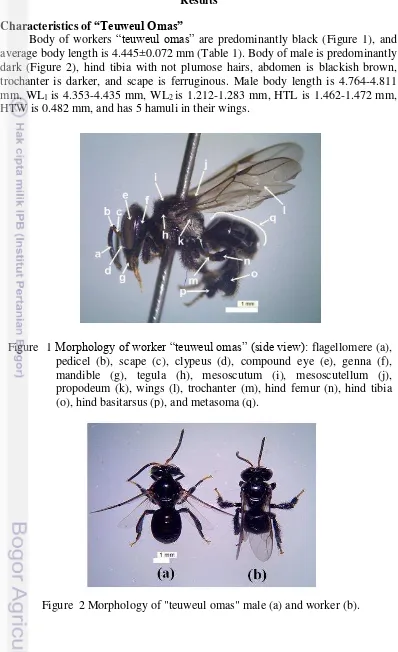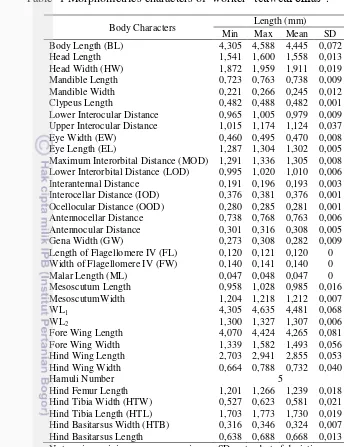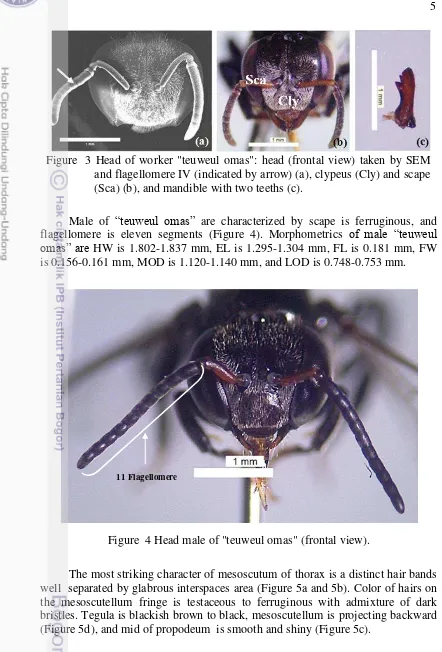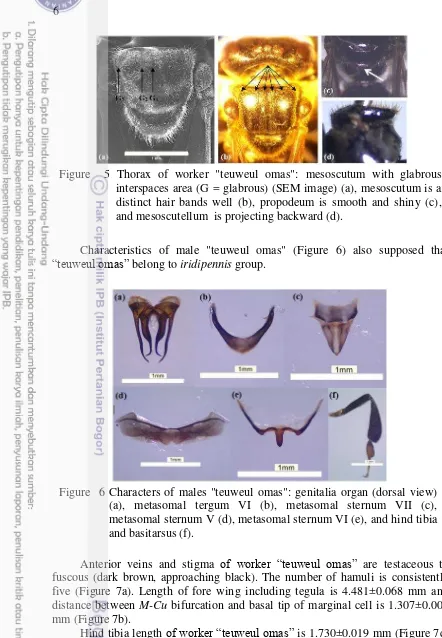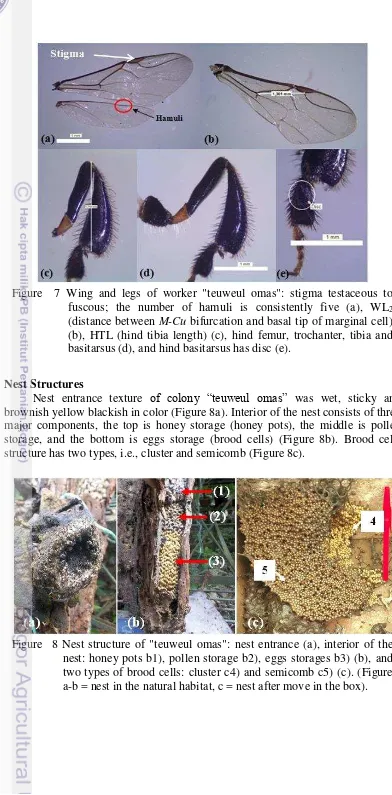MORPHOLOGICAL CHARACTERISTICS OF
"TEUWEUL OMAS" (
Trigona
sp.: HYMENOPTERA)
FROM WEST JAVA
ADE EFIN
DEPARTEMENT OF BIOLOGY
FACULTY OF MATHEMATICS AND NATURAL SCIENCES BOGOR AGRICULTURAL UNIVERSITY
PERNYATAAN MENGENAI SKRIPSI DAN
SUMBER INFORMASI SERTA PELIMPAHAN HAK CIPTA
Dengan ini saya menyatakan bahwa skripsi berjudul Morphological Characteristics of "Teuweul Omas" (Trigona sp.: Hymenoptera) from West Java adalah benar karya saya dengan arahan dari dosen pembimbing dan belum diajukan dalam bentuk apa pun kepada perguruan tinggi mana pun. Sumber informasi yang berasal atau dikutip dari karya yang diterbitkan maupun tidak diterbitkan dari penulis lain telah disebutkan dalam teks dan dicantumkan dalam Daftar Pustaka di bagian akhir skripsi ini.
Dengan ini saya melimpahkan hak cipta dari karya tulis saya kepada Institut Pertanian Bogor.
ABSTRACT
ADE EFIN. Morphological Characteristics of "Teuweul Omas" (Trigona sp.: Hymenoptera) from West Java. Supervised by TRI ATMOWIDI and TARUNI SRI PRAWASTI.
Stingless bees (Meliponini: Apidae) are eusocial insect with a highly organized system. Stingless bees are characterized by complex communication, permanent colonies, and has division of caste (queen, males, and workers). Trigona belong to stingless bees. In this research, we described morphological characteristics of "teuweul omas" (Trigona sp.) collected from Ciomas, Serang, Banten Province. Identification of specimen based on morphological characters and morphometric study, such as body length, characteristics of the head, thorax,
wings, and legs. Morphological characteristics of worker “teuweul omas” are
4.445±0.072 mm body length, 1.911±0.019 mm head width, mesoscutum with distinct hair bands (well banded) separated by glabrous interspaces area, with plumose frontal hairs, and black metasoma, legs, and hairs on the frontal. Based on morphological characteristics of the body, "teuweul omas" was grouped in the genus Trigona, subgenus Tetragonula, and iridipennis group.
Keywords: Morphological character, morphometric, stingless bee, Tetragonula
ABSTRAK
ADE EFIN. Karakteristik Morfologi "Teuweul Omas" (Trigona sp.: Hymenoptera) dari Jawa Barat. Dibimbing oleh TRI ATMOWIDI dan TARUNI SRI PRAWASTI.
Stingless bees (Meliponini: Apidae) merupakan serangga eusosial dengan sistem yang sangat terorganisir. Stingless bees ditandai dengan adanya komunikasi yang kompleks, koloni yang permanen, dan terdapat pembagian tugas di dalam kasta (ratu, jantan, dan pekerja). Trigona termasuk ke dalam stingless bees. Dalam penelitian ini, dideskripsikan morfologi “teuweul omas” (Trigona sp.) yang dikoleksi dari Ciomas, Serang, Provinsi Banten. Identifikasi spesimen dilakukan berdasarkan karakter morfologi dan studi morfometrik, yang meliputi pengukuran panjang tubuh, karakteristik kepala, thoraks, sayap, dan tungkai. Karakteristik morfologi dari "teuweul omas" pekerja adalah memiliki panjang tubuh 4.445±0.072 mm, lebar kepala 1.911±0.019 mm, mesoscutum dengan pola pita rambut yang jelas (well banded) yang dipisahkan oleh daerah glabrous interspaces, rambut-rambut pada bagian frontal plumose, memiliki metasoma, tungkai, rambut pada bagian frontal berwarna gelap. Berdasarkan karakteristik morfologi tubuh, “teuweul omas” termasuk ke dalam genus Trigona, subgenus Tetragonula, dan kelompok iridipennis.
An Undergraduate Thesis Intended to Acquire Bachelor Degree In Faculty of Mathematics and Natural Science
MORPHOLOGICAL CHARACTERISTICS OF
"TEUWEUL OMAS" (
Trigona
sp.: HYMENOPTERA)
FROM WEST JAVA
DEPARTMENT OF BIOLOGY
FACULTY OF MATHEMATICS AND NATURAL SCIENCES BOGOR AGRICULTURAL UNIVERSITY
BOGOR 2015
Undergraduate Thesis Title : Morpholo,ical Characteristics of "Teuweul Omas" (rigona sp.: Hymenoptera) rom West Java Name
NIM
Dr Tri MSi Supervisor I
: Ade Ein
: G34110068
Approved by
Acknowledged by
Dra Taruni MSi Supervisor II
Dr Ir Iman MSi
Head of Department Biology
ACKNOWLEDGEMENTS
All praise to Allah SWT for all the hope and gift I've got this far. The research titled Morphological Characteristics of "Teuweul Omas" (Trigona sp.: Hymenoptera) from West Java. The research was conducted from February to April 2015.
Deepest acknowledgements to Dr Tri Atmowidi, MSi and Dra Taruni Sri Prawasti, MSi as my supervisor for their advice and supervisions. Special acknowledgement to Prof Alex Hartana as examiner for the advice. Special acknowledgements addressed to Mr Gregori Garnadi Hambali, Prof Siti Salmah from Andalas University in Padang, Prof Charles D. Michener from the University of Kansas, Mr Abu Hassan Jalil from Malaysia, Dr Claus Rasmussen from the Aarhus University in Denmark, Dr Hans Bänziger from the Chiang Mai University in Thailand, Dr Karuppasamy Vijayakumar from India, members of the facebook group "Wisma Klanceng" and "Indo-Malayan Stingless Bees" that have helped during data collection. Expression of thanks are also addressed to My Father Azar (Alm.), My Mom Nadhiroh, Ella Susiani, Vida Yusnia, M. Romadhon for all the prayers and support, as well as to Eka Indah Umaiyah who has given his affection and also helped during the study.
Finally, I hope this research will be helpful for all the readers.
Bogor, September 2015
TABLE OF CONTENTS
LIST OF TABLE viii
LIST OF FIGURES viii
LIST OF APPENDIX viii
INTRODUCTION 1
Background 1
Objectives 1
MATERIALS AND METHODS 2
Research Methods 2
RESULTS AND DISCUSSION 3
Results 3
Discussion 8
CONCLUSION 10
REFERENCES 11
APPENDIX 13
LIST OF TABLE
1 Morphometrics characters of worker “teuweul omas” 4
LIST OF FIGURES
1 Morphology of worker “teuweul omas” (side view): flagellomere (a), pedicel (b), scape (c), clypeus (d), compound eye (e), genna (f), mandible (g), tegula (h), mesoscutum (i), mesoscutellum (j), propodeum (k), wings (l), trochanter (m), hind femur (n), hind tibia (o),
hind basitarsus (p), and metasoma (q). 3
2 Morphology of "teuweul omas" male (a) and worker (b). 3 3 Head of worker "teuweul omas": head (frontal view) taken by SEM and
flagellomere IV (indicated by arrow) (a), clypeus (Cly) and scape (Sca)
(b), and mandible with two teeths (c). 5
4 Head male of "teuweul omas" (frontal view). 5 5 Thorax of worker "teuweul omas": mesoscutum with glabrous
interspaces area (G = glabrous) (SEM image) (a), mesoscutum is a distinct hair bands well (b), propodeum is smooth and shiny (c), and
mesoscutellum is projecting backward (d). 6
6 Characters of males "teuweul omas": genitalia organ (dorsal view) (a), metasomal tergum VI (b), metasomal sternum VII (c), metasomal sternum V (d), metasomal sternum VI (e), and hind tibia and basitarsus
(f). 6
7 Wing and legs of worker "teuweul omas": stigma testaceous to fuscous; the number of hamuli is consistently five (a), WL2 (distance between
M-Cu bifurcation and basal tip of marginal cell) (b), HTL (hind tibia length) (c), hind femur, trochanter, tibia and basitarsus (d), and hind
basitarsus has disc (e). 7
8 Nest structure of "teuweul omas": nest entrance (a), interior of the nest: honey pots b1), pollen storage b2), eggs storages b3) (b), and two types of brood cells: cluster c4) and semicomb c5) (c). (Figure a-b = nest in the natural habitat, c = nest after move in the box). 7
APPENDIX
INTRODUCTION
Background
Stingless bees belong to the tribe Meliponini, family Apidae and subfamily Apinae (Michener 2007). Stingless bees are eusocial insects that living together in a colony with a highly organized system. They develop complex communication, build permanent colonies, and maintain a division of caste (i.e., queen, males, and workers). The queen has a different morphology with the workers. The queen body size is larger than males and the workers, and the workers are generally smaller than the males. In the world, stingless bees consist of more than 500 species (Michener 2013). Stingless bees have strong mandibles to defend and protect the colony from predators. Mandibles are used to bite their predators. They use propolis (also called bee-glue) to build the beehives and to protect againts pathogens. Stingless bees are important pollinators in various plant species (Slaa et al. 2006).
Trigona is one genus of stingless bees. Trigona is known as "klanceng or lanceng" in Java, "galo-galo" in Sumatra, "kelulut" in Borneo, and "ketape or emmu" in Sulawesi. Genus Trigona distributed in the neotropical regions (from Mexico to Argentina), Indo-Australian regions (India, Sri Lanka, Taiwan, Solomon Islands, the southern part of Indonesia, and New Guinea), and Australian region in latitude 34oS (Michener 2007). Nest of most Trigona species are in the hollow of trees or human houses, particularly eaves, and pillars of wooden houses (Sakagami 1983), bamboos (Starr and Sakagami 1987), and in the ant nest (Sakagami et al. 1989).
Studies of Trigona has been reported previously, such as activity T. laeviceps in polyculture and monoculture plantation (Guntoro 2013), effect of shade management on Trigona (Putra 2013), and flying activity of Trigona laeviceps (Wati 2013). Stingless bee (Trigona sp.) collected from Banten Province, was known as “teuweul omas”. “Teuweul” mean stingless bee (Sundanese) and
“omas” mean collected from Ciomas area, in Banten Province. Until now, the specimen has not been identified. In this study, we described morphological characteristics of “teuweul omas” (Trigona sp.) collected from Banten Province.
Objectives
2
MATERIALS AND METHODS
Research Methods
Sampling Methods. This study was carried out in February to April 2015. Samples of "teuweul omas" were obtained from an apiary owned by Gregori Garnadi Hambali in Baranangsiang Indah, Bogor, West Java (6°36'49.3" S, 106°49'29.2" E; 329 m a.s.l.). The colonies were taken from Banten Province. Samples of bees (n = 30 individuals of worker and 2 individuals of male) were taken from the colony and then preserved in 70% ethanol solution for morphometric measurement and identification process. Identification and measurement morphometrics were performed in the Laboratory of Biosystematics and Animal Ecology, Department of Biology, Faculty of Mathematics and Natural Science, Bogor Agricultural University.
Specimen Identification. Bee specimens were identified based on morphological characters and morphometric measurements as described by Sakagami (1978), Sakagami and Inoue (1987), and Sakagami et al. (1990). Morphometric measurements were performed using a stereo microscope Nikon Model C-LEDS mounted with Optilab viewer and Image Raster software. Morphometric measurement of Trigona sp. consist of body length (BL), maximum head width (HW) (Sakagami 1978), head length, clypeus length, lower and upper interocular distance, interantennal distance, antennocellar distance, antennocular distance (modification of Michener 2007), length and width of eyes (EL and EW), maximum and lower interorbital distances (MOD and LOD), interocellar distance (IOD), ocellocular distance (OOD), maximum width of gena (GW), minimum malar length (ML), length and width of flagellomere IV (FL and FW) (Sakagami 1978), length and width of mandible teeth, length and width of mesoscutum (Rasmussen 2013), length of fore wing including tegula (WL1),
distance between M-Cu bifurcation and basal tip of marginal cell (WL2)
(Sakagami 1978), length and width of fore wing, length and width of hind wing, hamuli number (Klakasikorn et al. 2005), hind tibia length (HTL), maximum width of hind tibia and hind basitarsus (HTW and HBW) (Sakagami 1978), femur length and hind basitarsus (Klakasikorn et al. 2005).
3
RESULTS AND DISCUSSION
Results Characteristics of “Teuweul Omas”
Body of workers “teuweul omas” are predominantly black (Figure 1), and average body length is 4.445±0.072 mm (Table 1). Body of male is predominantly dark (Figure 2), hind tibia with not plumose hairs, abdomen is blackish brown, trochanter is darker, and scape is ferruginous. Male body length is 4.764-4.811 mm, WL1 is 4.353-4.435 mm, WL2 is 1.212-1.283 mm, HTL is 1.462-1.472 mm,
HTW is 0.482 mm, and has 5 hamuli in their wings.
Figure 2 Morphology of "teuweul omas" male (a) and worker (b). Figure 1 Morphology of worker “teuweul omas” (side view): flagellomere (a),
4
Table 1 Morphometrics characters of worker “teuweul omas”.
Body Characters Length (mm)
Lower Interocular Distance 0,965 1,005 0,979 0,009
Upper Interocular Distance 1,015 1,174 1,124 0,037
Eye Width (EW) 0,460 0,495 0,470 0,008
Eye Length (EL) 1,287 1,304 1,302 0,005
Maximum Interorbital Distance (MOD) 1,291 1,336 1,305 0,008
Lower Interorbital Distance (LOD) 0,995 1,020 1,010 0,006
Interantennal Distance 0,191 0,196 0,193 0,003
Interocellar Distance (IOD) 0,376 0,381 0,376 0,001
Ocellocular Distance (OOD) 0,280 0,285 0,281 0,001
Antennocellar Distance 0,738 0,768 0,763 0,006
Antennocular Distance 0,301 0,316 0,308 0,005
Gena Width (GW) 0,273 0,308 0,282 0,009
Length of Flagellomere IV (FL) 0,120 0,121 0,120 0
Width of Flagellomere IV (FW) 0,140 0,141 0,140 0
Malar Length (ML) 0,047 0,048 0,047 0
Mesoscutum Length 0,958 1,028 0,985 0,016
MesoscutumWidth 1,204 1,218 1,212 0,007
WL1 4,305 4,635 4,481 0,068
Hind Basitarsus Length 0,638 0,688 0,668 0,013
Note: min = minimum, max = maximum, SD = standart of deviation
5
Male of “teuweul omas” are characterized by scape is ferruginous, and flagellomere is eleven segments (Figure 4). Morphometrics of male “teuweul
omas” are HW is 1.802-1.837 mm, EL is 1.295-1.304 mm, FL is 0.181 mm, FW is 0.156-0.161 mm, MOD is 1.120-1.140 mm, and LOD is 0.748-0.753 mm.
The most striking character of mesoscutum of thorax is a distinct hair bands well separated by glabrous interspaces area (Figure 5a and 5b). Color of hairs on the mesoscutellum fringe is testaceous to ferruginous with admixture of dark bristles. Tegula is blackish brown to black, mesoscutellum is projecting backward (Figure 5d), and mid of propodeum is smooth and shiny (Figure 5c).
Figure 4 Head male of "teuweul omas" (frontal view).
Figure 3 Head of worker "teuweul omas": head (frontal view) taken by SEM and flagellomere IV (indicated by arrow) (a), clypeus (Cly) and scape (Sca) (b), and mandible with two teeths (c).
6
Characteristics of male "teuweul omas" (Figure 6) also supposed that
“teuweul omas” belong to iridipennis group.
Anterior veins and stigma of worker “teuweul omas” are testaceous to fuscous (dark brown, approaching black). The number of hamuli is consistently five (Figure 7a). Length of fore wing including tegula is 4.481±0.068 mm and distance between M-Cu bifurcation and basal tip of marginal cell is 1.307±0.006 mm (Figure 7b).
Hind tibia length of worker “teuweul omas” is 1.730±0.019 mm (Figure 7c) and the trochanter is testaceous. Femur, hind tibia, and hind basitarsus are blackish brown to black (Figure 7d). Hind tibia is consistently with plumose hairs and hind basitarsus has disc (Figure 7e). Hairs on the fringe of hind tibia and hind basitarsus is brown to black.
Figure 6 Characters of males "teuweul omas": genitalia organ (dorsal view) (a), metasomal tergum VI (b), metasomal sternum VII (c), metasomal sternum V (d), metasomal sternum VI (e), and hind tibia and basitarsus (f).
7
Nest Structures
Nest entrance texture of colony “teuweul omas” was wet, sticky and brownish yellow blackish in color (Figure 8a). Interior of the nest consists of three major components, the top is honey storage (honey pots), the middle is pollen storage, and the bottom is eggs storage (brood cells) (Figure 8b). Brood cells structure has two types, i.e., cluster and semicomb (Figure 8c).
Figure 8 Nest structure of "teuweul omas": nest entrance (a), interior of the nest: honey pots b1), pollen storage b2), eggs storages b3) (b), and two types of brood cells: cluster c4) and semicomb c5) (c). (Figure a-b = nest in the natural habitat, c = nest after move in the box). Figure 7 Wing and legs of worker "teuweul omas": stigma testaceous to
fuscous; the number of hamuli is consistently five (a), WL2
8
Discussion
Based on the characters that have been described, "teuweul omas" belongs to genus Trigona and subgenus Tetragonula. Morphological characters of "teuweul omas" described were similar with subgenus Tetragonula as that described by Sakagami et al. (1990). Those characters are a fringe of hind tibia is covered mostly by plumose hairs, a disc on hind basitarsus, mandible with two teeth, the mid part of propodeum is smooth and shiny, mesoscutellum is clearly projecting backward, and malar space shorter than half the width of flagellomere II (Figure 3a). “Teuweul omas” characters also similar with that reported by Sakagami (1978), there are flagellomere length is shorter than its width, flagellomere II is slightly longer than the first segment, the number of hamuli is 5, and the body size is relative small.
Based on morphological characters and morphometric measurements, "teuweul omas" is similar to Trigona (Tetragonula) laeviceps and T. (T.) zucchii. However, the body size of "teuweul omas" is larger than T. (T.) laeviceps, but smaller than T. (T. ) zucchii. In addition, T. (T.) laeviceps and T. (T.) zucchii are not well banded, whereas "teuweul omas" is well banded (Figure 2c). Sakagami et al. (1990) also reported, that the surface of T. (T.) laeviceps mesoscutum is without hairs (glabrous), and specifically in the lateral is not flashy nor visible. The abdomen of T. (T.) laeviceps is ferruginous (Smith 1857) and the frontal hairs are not plumose (Sakagami 1978). However, "teuweul omas" abdomen is dark and the frontal hairs is plumose.
"Teuweul omas" also differ with T. (T.) minor, body size of "teuweul omas" is bigger, clypeus and venation of hind wing are also different with T. (T.) minor as was described by Klakasikorn et al. (2005). "Teuweul omas" also have bigger body size than T. (T.) pagdeni. Tetragonula (T.) pagdeni has a silvery gray color on anterior corbicular fringe, withish frontal hairs, and their metasoma and legs are relatively pale. Contrary, metasoma, legs, and anterior corbicular fringe of
“teuweul omas” are dark and their frontal hairs are mainly dark.
Compared to T. (T.) hirashimai, “teuweul omas” have smaller body size. The male genital structure of “teuweul omas” is different with T. (T.) hirashimai (Sakagami 1978; Sakagami and Inoue 1987) and T. (T.) iridipennis (Sakagami 1978; Sakagami and Inoue 1987). However, the male genital structure of "teuweul omas" is similar with T. (T.) minangkabau, although the other characteristics of male body are different (Sakagami and Inoue 1985). Moreover, T. (T.) minangkabau body size is smaller than "teuweul omas" and bicolorous.
Group of iridipennis is characterized by mesoscutum with four distinct hair bands separated by glabrous interspaces area (Rasmussen 2013). Mesoscutum with glabrous interspaces is the key characteristics of the iridipennis group (Sakagami 1978; Rasmussen 2013; Vijayakumar and Jeyaraaj 2014). "Teuweul omas" observed has four distinct hair bands on mesoscutum (Figure 5b) separated by glabrous interspaces area (Figure 5a), and we supposed that the specimen belongs to iridipennis group.
9 two types of brood cell structures, i.e. cluster and semicomb (Figure 8c). Semicomb nest resembles a comb shape but irregular. Sakagami et al. (1983) reported that the structure of nest entrance in stingless bees can not be used as the benchmark for the identification of species. This is due to the entrance of the hive can change according the situation and condition of the environment. Sakagami (1978) also reported that the main difficulty in the identification of Tetragonula is that there are not typical characteristics that can be relied upon as differentiator between worker bees. As a result, the classification must depend on the size, proportion, coloration, and pilosity (associated with hair). The characters sometimes are difficult or often impossible to be observed. Morphological characters are not fully able to identify the species correctly, it needs additional data, such as molecular analysis data to identify at species level. Based on ratio of WL2/HW, HTL/HW, HTL/WL2, EL/MOD, LOD/MOD, IOD/OOD, GW/EW,
10
CONCLUSION
11
REFERENCES
Guntoro YP. 2013. Aktivitas dan produktivitas lebah Trigona laeviceps di kebun polikultur dan monokultur pala (Myristica fragrans) [skripsi]. Bogor (ID): Institut Pertanian Bogor.
Klakasikorn A, Wongsiri S, Deowanish S, Duangphakdee O. 2005. New record of stingless bees (Meliponini: Trigona) in Thailand. Nat Hist J Chulalongkorn Univ. 5(1):1-7.
Michener CD. 2007. The Bees of the World. Second Edition. Baltimore (US): The Johns Hopkins Univ. Pr.
Michener CD. 2013. The Meliponini. In: Vit P, Pedro SRM, Roubik DW, editor. Pot-Honey: A Legacy of Stingless Bees. New York, USA. New York (US): Springer Pp 3-17.
Putra H. 2013. Pengaruh manajemen naungan stup terhadap aktivitas terbang galo-galo (Trigona drescheri) di Sumanik Sumatera Barat [skripsi]. Bogor (ID): Institut Pertanian Bogor.
Rasmussen C. 2013. Stingless bees (Hymenoptera: Apidae: Meliponini) of the Indian subcontinent: diversity, taxonomy and current status of knowledge. Zootaxa 3647(3):401-428.
Sakagami SF. 1978. Tetragonula stingless bees of the continental Asia and Sri Lanka (Hymenoptera, Apidae). J Fac Agr Hokkaido Univ. 21(2):165-247. Sakagami SF, Inoue T, Yamane S, Salmah S. 1983. Nest architecture and colony
composition of the Sumatran stingless bee Trigona (Tetragonula) laeviceps. Kontyû 51(1):100-111.
Sakagami SF, Inoue T. 1985. Taxonomic notes on three bicolorous Tetragonula stingless bees in Southeast Asia. Kontyû 53(1):174–189.
Sakagami SF, Inoue T. 1987. Stingless bees of the genus Trigona (subgen Trigonella) with notes on the reduction of spatha in male genitalia of the subgenus Tetragonula (Hymenoptera, Apidae). Kontyû 55(4):610–627. Sakagami SF, Inoue T, Yamane S, Salmah S. 1989. Nests of the Myrmecophilous
stingless bee, Trigona moorei: how do bees initiate their nest within an arboreal ant nest?. Biotropica 21(3):265-274.
Sakagami SF, Inoue T, Salmah S. 1990. Stingless bees of central Sumatra. In: Sakagami SF, Ohgushi R, Roubik DW, editor. Natural History of Social Wasps and Bees in Equatorial Sumatra; Sapporo, Jepang. Sapporo (JP): Hokkaido Univ. Pr. Pp 125-137.
Slaa EJ, Chaves LAS, Malagodi-Braga KS, Hofstede FE. 2006. Stingless bees in applied pollination: practice and perspectives. Apidologie 37(2):293–315. Smith F. 1857. Catalogue of the hymenopterous insects collected at Sarawak,
Borneo; Mount Ophir, Malacca; and at Singapore, by A. R. Wallace. J Proc Linnean Soc, Zoo. 2:42–88.
Starr CK, Sakagami SF. 1987. An extraordinary concentration of stingless bee colonies in the Philippines, with notes on nest structure (Hymenoptera: Apidae: Trigona spp.). Insectes Sociaux, Paris 34(2):96-107.
12
13
15 Appendix 1 Ratio of several characters of worker “teuweul omas”.
Ratio of characters Minimum* Maximum* Mean SD
WL2/HW 0,668 0,695 0,684 0,006
HTL/HW 0,877 0,922 0,906 0,010
HTL/WL2 1,301 1,351 1,324 0,012
EL/MOD 0,976 1,006 0,998 0,006
LOD/MOD 0,756 0,780 0,774 0,005
IOD/OOD 1,319 1,361 1,337 0,007
GW/EW 0,574 0,643 0,600 0,020
ML/FW 0,333 0,343 0,336 0,002
FL/FW 0,851 0,864 0,857 0,002
HTW/HTL 0,305 0,357 0,336 0,013
HBW/HTW 0,520 0,628 0,558 0,022
Note: (*) Minimum and maximum value taken from measurement character ratio 30 individuals of
16
